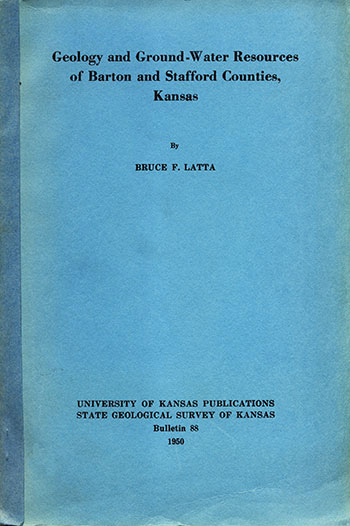Geology and Ground-water Resources of Barton and Stafford Counties, Kansas
by Bruce F. Latta

Originally published in 1950 as Kansas Geological Survey Bulletin 88. This is, in general, the original text as published in 1950. The information has not been updated. An Acrobat PDF version (117 MB) is also available.
You may also wish to visit our web sites on the Barton and Stafford county geologic maps.
Abstract
This report describes the geography, geology, and groundwater resources of Barton and Stafford Counties in central Kansas. These counties have an area of about 1,686 square miles and had a population of 35,885 in 1945. Stafford County and most of Barton County are drained by Arkansas River and its tributaries. The northern part of Barton County is drained by tributaries of Smoky Hill River. The climate is sub-humid, the average annual precipitation being about 24 inches. Farming and raising of livestock are the principal occupations. Also, Barton and Stafford Counties are among the most important oil-producing counties in the State.
All the rocks exposed in Barton and Stafford Counties are of sedimentary origin and range in age from Cretaceous to Recent. The areal distribution of the formations is shown in Plate 1. The oldest Cretaceous rocks exposed at the surface are Lower Cretaceous (Comanchean) in age and comprise part of the Kiowa shale. The Upper Cretaceous (Gulfian) is represented by the Dakota formation, Graneros shale, Greenhorn limestone, and Carlile shale, which are exposed in the upland areas of Barton County. In northern and western Barton County thin deposits of "Algal limestone" of Tertiary age crop out at scattered localities.
Undifferentiated deposits of silt, clay, and gravel of early Pleistocene age are exposed in a small area in northwestern Barton County where they unconformably overlie the Carlile shale. Unconsolidated deposits of silt, sand, and gravel (Meade formation) of early Pleistocene age cover the eroded surface of Cretaceous and Permian rocks in some areas in southern Barton and all of Stafford Counties. These deposits are exposed along Rattlesnake Creek and North Fork of Ninnescah Creek in southern Stafford County. Later Pleistocene silts, sands, and gravels underlie parts of the upland in southern Barton County, the Cow Creek drainage basin, and terraces along Walnut and Dry Walnut Creek. Quaternary dune sand covers the surface in most of Stafford County and southern Barton County, and alluvium underlies the surface of the larger stream valleys and Cheyenne Bottoms.
The alluvium yields large amounts of water to wells in Arkansas and Walnut Valleys and small to moderate amounts to wells in Cheyenne Bottoms and smaller stream valleys. It supplies water to many irrigation and a few industrial wells in Arkansas and Walnut Valleys. Waters in most places are hard but otherwise are satisfactory for most purposes. However, waters of poor quality are found in Cheyenne Bottoms and Big and Little Marshes.
Sand and gravel beds of the Meade formation are the most important sources of water in Stafford County and southern Barton County, and yield large supplies. Most of the domestic and stock wells and all the irrigation and public-supply wells south of Arkansas Valley derive water from this formation, and many of the domestic, stock, irrigation, and industrial wells in the Arkansas Valley and the city-supply wells at Great Bend derive all or a part of their water from it. In most areas the water is of good quality, but locally it is highly mineralized.
The report contains a map showing by means of contours the saturated thickness of the water-bearing materials of post-cretaceous age. In parts of the area those water-bearing materials have a total saturated thickness of as much as 200 feet.
The field data upon which most of this report is based are given in tables that include records of 371 wells, 43 of which are irrigation wells, and chemical analyses of water from 100 representative wells and test holes. Logs of 130 test holes, water wells, and oil-test wells, including 106 test holes put down by the State Geological Survey, are given.
Kansas Geological Survey, Barton and Stafford Geohydrology
Web version Dec. 2001. Original publication date Dec. 1950.
Comments to webadmin@kgs.ku.edu
The URL for this page is http://www.kgs.ku.edu/General/Geology/Barton/index.html